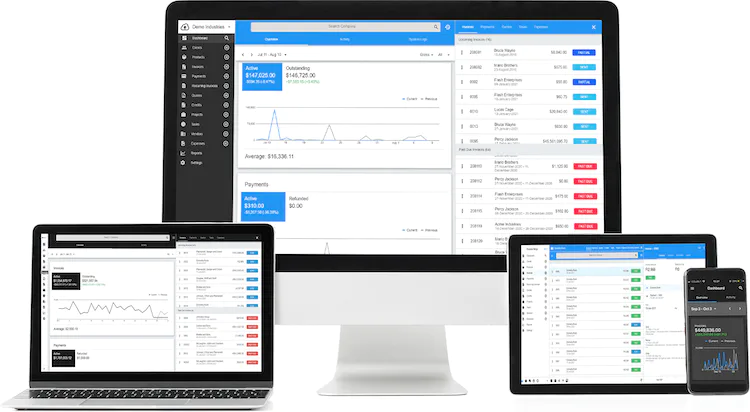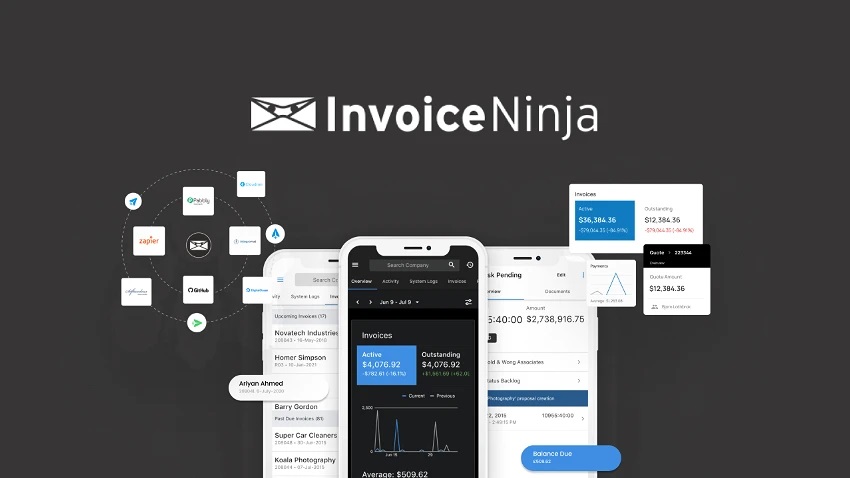If you’re looking to use Invoice Ninja, you’ll need a few things to get started. Here’s a breakdown of the key Invoice Ninja requirements:
1. PHP Version
Invoice Ninja is a software tool made with PHP, which is a common computer language used for building things on the internet. To run Invoice Ninja, you’ll need to have PHP version 7.1 or 7.2. Some people have said that there can be problems if you try to use PHP 8.1, so it’s a good idea to make sure that the version of PHP you want to use will work well with Invoice Ninja.
2. MySQL Database
Invoice Ninja relies on MySQL as its database management system. Let’s dive into some key details about Invoice Ninja’s MySQL database.
a). Database Setup
To get started with Invoice Ninja, you’ll need a MySQL compatible database. You can create this database in your shared host control panel. Don’t forget to set up a database user as well.
b). MySQL Version
While the precise MySQL or MariaDB version required for Invoice Ninja isn’t crystal clear from our research, some users have encountered problems when trying to install Invoice Ninja on shared servers with outdated MySQL or MariaDB versions.
c). Integration with MySQL
Invoice Ninja offers the exciting possibility of integration with MySQL. This integration empowers you to create robust workflows by utilizing automation tools like n8n.
d). Configuration Essentials
Properly configuring your database is crucial for using Invoice Ninja. This includes creating a database on your MySQL compatible server and granting a user full access to that database.
e). Compatibility Concerns
Users have mentioned experiencing issues when installing Invoice Ninja on servers that use Nginx and MySQL. However, it’s worth noting that these issues don’t seem to stem from the MySQL database itself.
f). SQL Database Import
If you already have SQL databases, you can import them into Invoice Ninja. Keep in mind that the specific steps for doing this may vary depending on how your system is set up.
In a nutshell, Invoice Ninja’s MySQL database is at the core of its operations. While some version compatibility and setup challenges may arise, it opens doors to powerful automation possibilities. Always ensure that your MySQL setup aligns with Invoice Ninja’s requirements for a seamless experience.
3. Laravel Framework
Invoice Ninja is a special invoicing application. It’s made using something called the Laravel framework, which is a famous tool for creating websites using a computer language called PHP.
So, what’s this Laravel thing? Well, it’s a free and open-source framework for PHP. It’s kind of like a set of building blocks that help people create websites.
This framework provides a bunch of helpful things to build websites. It has tools like routing, middleware, controllers, and views. These are like different tools in a toolbox for a builder.
People really like using Laravel because it makes writing code easier. It has a fancy way of writing code that’s easy to understand, even for computer nerds. It’s like writing in a neat and clear handwriting.
Invoice Ninja is also able to do lots of cool things because it uses the Laravel framework. It can create custom fields, make itself look different for different companies, and even talk to other computer programs through something called an API.
4. Operating System
Invoice Ninja is a super useful invoicing application that can be put on different computer systems like Ubuntu, CentOS, and Arch Linux. To make it work, you need something called a LAMP stack (Linux, Apache, MySQL, PHP), and also something called the Laravel framework, which is made using PHP.
5. Web Server
Invoice Ninja needs a web server to serve up its web pages. You can pick between Apache or Nginx. These are like the waiters who bring you the menu at a restaurant.
Read also: Invoice Ninja Delivery Note: Simplify Your Business Operations
Installing Invoice Ninja on Apache
If you want to use Invoice Ninja on a server that runs Apache, you can do it. The process is quite similar to when you use Nginx. Here are the main steps you need to follow:
Step 1: Download Invoice Ninja
Start by downloading the Invoice Ninja installation zip file right onto your server. This file is important because it contains all the things you need to get Invoice Ninja up and running.
Step 2: Create a Database
You’ll also need a special place to store all the information Invoice Ninja uses. It’s like a digital filing cabinet. You can make this place by creating a database and a user. You can use either MySQL or MariaDB for this.
Step 3: Install PHP and its Friends
Invoice Ninja speaks a language called PHP. To understand it, you need to install PHP and some special extras called PHP extensions. These extensions help PHP do its job better.
Step 4: Get Laravel Ready
Invoice Ninja is built on something called the Laravel framework. Think of it like the foundation of a house. You need to install this framework so that Invoice Ninja can stand tall and work properly.
Step 5: Teach Apache to Serve
Apache, the server software, needs to know how to share Invoice Ninja with the world. You do this by configuring Apache. It’s like telling a waiter what food to serve at a restaurant.
Step 6: Restart and Start
After you’ve done all this, it’s time to restart Apache. This is like giving your computer a little nap so it can wake up refreshed. Once it’s up again, you can visit a special page called the Invoice Ninja setup wizard. This page will help you finish the installation.
So, there you go! Those are the steps to put Invoice Ninja on a server with Apache. It might seem like a lot, but each step is important to make sure Invoice Ninja works smoothly on your server. Good luck!
Understanding How Much RAM You Need for Invoice Ninja
When you want to use Invoice Ninja, you might wonder how much computer memory, or RAM, you need. RAM is like your computer’s brain; it helps it run smoothly.
Here’s what you should know:
1. No Clear Minimum
You might search and not find an exact answer about the least amount of RAM you need for Invoice Ninja. It’s a bit like asking how much water you need to make lemonade – the answer depends on a few things.
2. User Reports
Some folks say they can use Invoice Ninja with just 2GB of RAM. That’s like having two big jars of peanut butter – it might work, but it could get slow if you have too much on your sandwich.
3. It’s Not Always the Same
The amount of RAM you need can change. Imagine you’re playing with building blocks – sometimes, you need more if you’re building a big tower, and less if you’re making a small house. Invoice Ninja can be like that, too.
4. Check the Manual
To be sure, it’s a good idea to look at the Invoice Ninja instruction book. Think of it like checking a recipe to see how many eggs you need for a cake. The book will tell you what works best for each version of Invoice Ninja.
5. Ask for Help
If you’re not sure, it’s okay to ask someone. Maybe you have a friend who knows a lot about Invoice Ninja, or you can talk to the friendly people who use it too. Sometimes, experts can help you figure out what’s best for your computer.
How to Install Invoice Ninja on a Windows Server
1. Download Invoice Ninja
Start by grabbing the latest version of Invoice Ninja from the official website.
2. Extract Files
Once downloaded, extract the Invoice Ninja files to a folder on your server. This is like opening a gift box to find what’s inside.
3. Create a Database
Using MySQL or MariaDB, create a database specifically for Invoice Ninja. Think of this as giving it a dedicated place to store its data.
4. Configurations
Open the ‘config/database.php’ file in a text editor. Here, you’ll update the database credentials, kind of like setting up a password for your phone.
5. Environment Settings
Now, open the ‘.env’ file in a text editor. Here, you’ll update the ‘APP_URL’ setting to match the URL where Invoice Ninja will live. This is like telling your GPS where your house is.
6. Install Dependencies
Run a command called ‘composer install.’ This is like getting all the ingredients ready before cooking a meal.
7. Generate Application Key
Run ‘php artisan key:generate’ to create a special key for Invoice Ninja. Think of it as a secret handshake.
8. Migrate the Database
Run ‘php artisan migrate’ to set up the Invoice Ninja database. It’s like preparing your workspace before starting a project.
9. Access Setup Wizard
Open a web browser and go to the URL where you installed Invoice Ninja. You should see a setup wizard, like the friendly guide at a theme park.
10. Follow the Wizard
Follow the steps in the setup wizard to finish the installation. It’s like putting together a puzzle with clear instructions.
Read also: Invoice Ninja Windows App: How To Use It
Additional Tips
- Always use the latest PHP and MySQL/MariaDB versions for a smoother experience.
- If you’re using NGINX, make sure to install the PHP FPM module for compatibility.
- For Apache users, enable the mod_rewrite module to make sure everything works smoothly.
- It’s a good idea to create a dedicated user account just for Invoice Ninja. This keeps things organized.
Once the installation is complete, you’re ready to log in to Invoice Ninja and start managing your invoices, clients, and payments. It’s like having a trusty assistant to handle your finances.
Read also: Is Invoice Ninja Safe? A Review Of Its Security Practices
Final Thought on Invoice Ninja Requirements
Now, what can you do with Invoice Ninja? Well, quite a lot! You can make invoices and send them out, keep an eye on your expenses, deal with your vendors, and even make your work go smoother with automation.
But wait, there’s more! It can connect with different payment gateways like Stripe, WePay, and Authorize.net. This makes it super easy for your clients to pay their bills with just one click.
Who’s it for? Well, it’s made for small to medium-sized companies and freelancers. It’s pretty flexible too. You can tweak your invoices the way you like with customizable templates. It can also handle recurring bills, do auto-billing, keep track of your time, and help you manage your expenses better.
To be sure you’ve got everything right, it’s a good idea to check out the official Invoice Ninja documentation. If you’re ever stuck, you can also chat with the friendly Invoice Ninja community or get help from an Invoice Ninja expert. They’re like the friendly neighborhood superheroes of invoicing!






